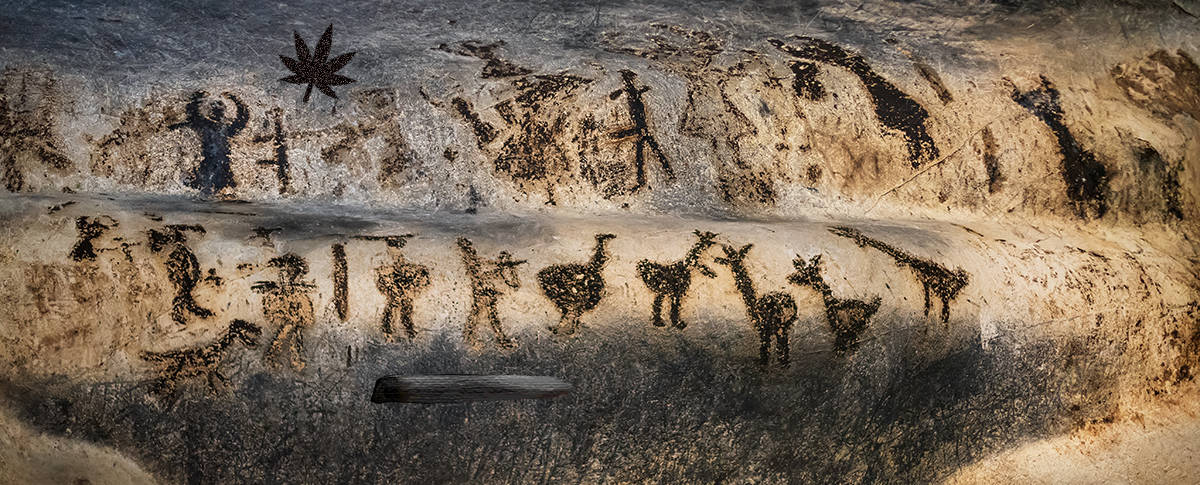
Brief History of Cannabis
- Early Uses and Cultural Significance
- Cannabis in Traditional Medicine
- Cannabis Enters the Western World
- Cannabis in the 19th to Early 20th Century
- The Rise and Fall of Cannabis Prohibition
- Modern Era: Cannabis Reforms and Medical Discoveries
- Cannabis Legalization and the 21st Century
- Global Perspectives on Cannabis
- The Future of Cannabis
- Conclusion
In this comprehensive exploration of the history of cannabis, we will delve into the rich and varied past of this plant, tracing its cultural, medicinal, and societal significance throughout the ages. From ancient civilizations to modern times, we will uncover the evolution of cannabis usage and its changing perceptions across different regions of the world.
This post is intended as information and for general knowledge only. It is not a substitute for medical advice, diagnosis, or treatment. It is recommended that you talk to a healthcare professional about this before introducing cannabinoids into your daily routine (especially if you have been diagnosed with any medical conditions or are under any medication). It is not recommended to drive or operate any machinery when using cannabis- or hemp-derived products. Use responsibly!
Early Uses and Cultural Significance
Ancient Archaeological Evidence of Cannabis Use

Cannabis, known as cannabis sativa, has a history as old as human civilization itself. Archaeological excavations have unearthed traces of cannabis in burial sites and artifacts dating back thousands of years. These findings offer a glimpse into the early uses of cannabis by our ancestors, shedding light on its profound cultural significance.
Use of cannabis in religious ceremonies by ancient cultures
The history of cannabis intertwines with religious practices in many ancient cultures. For instance, the Scythians, a nomadic group from Central Asia, used cannabis in their religious rituals. This early connection between cannabis and spirituality laid the foundation for its continued role in various belief systems.
Cannabis in Early Religious Rituals and Cultural Practices
Across the vast expanse of the Middle East and Asia, cannabis took on a central role in religious ceremonies. Ancient Hindu rituals, for example, incorporated cannabis as a sacrament. The symbolic and spiritual significance attributed to cannabis in these societies underscores its profound impact on cultural practices.
Historical References in Texts and Literature
References to cannabis can be found in ancient texts and literature from around the world. The Vedas, sacred Hindu scriptures, contain mentions of cannabis as a sacred herb with the power to liberate the mind. The Bible, too, alludes to the use of “kaneh-bosm,” which some suggest may have been cannabis. In ancient China, pharmacopoeias and medical manuscripts made reference to cannabis, recognizing its potential therapeutic properties.
Cannabis in Traditional Medicine
Early Medicinal Applications in Ancient Practices
The history of cannabis in traditional medicine is deeply rooted in ancient China, where it was used for pain relief and therapeutic purposes. Similarly, traditional Indian medicine, known as Ayurveda, employed cannabis remedies to alleviate suffering and promote healing. These early medicinal applications highlight the plant’s enduring role in human health.

Documented Uses for Pain Relief and Ailments
Throughout history, cannabis has been documented as a remedy for a wide range of ailments. From treating pain and nausea to addressing various health issues, cannabis-based preparations were used in diverse cultures. These remedies served as a testament to the plant’s versatility and therapeutic potential.
Cannabis as Part of Traditional Pharmacopeias
Cannabis found its place within the pharmacopeias of various cultures, including Persian medicine. The integration of cannabis into traditional healing systems demonstrated its acceptance and utility as a medicinal resource. These early pharmacological explorations contributed to the broader understanding of plant-based medicine.
Influence of Cannabis on Early Medical Knowledge
Cannabis was a vital contributor to the development of early medical knowledge. As different cultures exchanged ideas and medicinal practices, cannabis played a role in advancing the understanding of plant-based medicine. Its influence extended beyond its direct use, shaping the evolving landscape of medical practices.
Cannabis Enters the Western World
Exploration, Trade, and Cultural Exchanges
As exploration and trade routes connected the East to the West, cannabis made its way to Europe and the Americas. The exotic nature of the plant fascinated Western cultures, leading to further exploration and study. This marked the beginning of a new chapter in the history of cannabis.
Introduction of Cannabis to Europe and the Americas
Cannabis reached Europe and the Americas through these early global connections. The first instances of cannabis being brought to these continents opened doors to experimentation and inquiry. Western societies were introduced to the plant’s potential uses.
Initial Uses in Western Medicine and Apothecaries
Western medical practitioners began to incorporate cannabis into their treatments. Cannabis tinctures and preparations became available in apothecaries, recognizing the plant’s potential therapeutic benefits. This period marked a gradual integration of cannabis into Western medicine.
Shifts in Perceptions and Regulations
Initially, cannabis was viewed as a valuable medicine in the West. However, as cultural clashes and emerging concerns took root, perceptions began to shift. The plant’s potential threat to society started to overshadow its medicinal benefits, leading to the first regulations on cannabis.
Cannabis in the 19th to Early 20th Century
Cannabis Extracts in Patent Medicines and Tonics
The 19th century witnessed the commercialization of cannabis-based products. Patent medicines and tonics containing cannabis extracts flooded the market. Marketers touted these products as cure-alls, capitalizing on the plant’s reputation for health and wellness.
Emergence of Recreational Use and Cultural Circles
During the 19th century, cannabis began to find its place in artistic and literary communities. Writers and artists of the time explored its effects, and cannabis became a symbol of counterculture and creativity. Literature and art from this period often depicted cannabis in various forms.
Early Medical Studies on Cannabis Components
Scientific inquiry into cannabis gained momentum in the 19th and early 20th centuries. Researchers isolated cannabis compounds and conducted studies on their effects. These studies laid the foundation for our modernunderstanding of cannabinoids and their interactions with the human body.
Regulatory Actions and the Beginning of Legal Restrictions
As the 20th century dawned, rapid changes in cannabis regulations occurred. What was once freely available now faced growing scrutiny. Influential factors, including sensationalized stories and political interests, contributed to the enactment of anti-cannabis laws and regulations.
The Rise and Fall of Cannabis Prohibition

Factors Contributing to Criminalization
The criminalization of cannabis was driven by a complex interplay of factors. Sensationalized stories, often fueled by racial biases, played a significant role in shaping public opinion. Meanwhile, political and economic interests provided a powerful impetus for the prohibition movement.
Role of Sensationalism and Political Agendas
The media played a pivotal role in influencing public perception of cannabis users. Sensationalized stories, often referred to as “Reefer Madness,” portrayed cannabis users as dangerous and unhinged. These portrayals were used to advance political campaigns and anti-drug propaganda.
Creation of Regulatory Frameworks and Anti-Cannabis Laws
A timeline of key legislative acts and policies, such as the Marihuana Tax Act and the Boggs Act, reveals the progression of cannabis prohibition. These laws established agencies like the Federal Bureau of Narcotics to enforce the ban on cannabis. Social and Cultural Impacts of Prohibition The prohibition of cannabis had far-reaching social and cultural implications. It disproportionately affected marginalized communities, contributing to long-lasting stigmatization of cannabis users.
Modern Era: Cannabis Reforms and Medical Discoveries
Emergence of Counterculture Movements and Changing Perceptions
The 1960s and 1970s saw cannabis become closely associated with counterculture movements. As public attitudes towards cannabis shifted, the plant found a new place in society. The changing perception of cannabis was a harbinger of the reforms to come.
Medical Research and Discovery of Cannabinoids
Scientific research in the latter half of the 20th century led to significant breakthroughs in understanding cannabinoids. Major compounds like THC and CBD were isolated and studied. Researchers unveiled the endocannabinoid system, shedding light on how cannabis interacts with the human body.
Efforts Towards Decriminalization and Medical Cannabis Legalization
Early initiatives aimed at decriminalizing cannabis possession gained traction. Additionally, pioneering cases of medical cannabis legalization demonstrated the potential of the plant for therapeutic purposes. These efforts marked a turning point in the history of cannabis legislation.
Cannabis Legalization and the 21st Century
Pioneering Countries and States in Legalization
The 21st century witnessed a wave of cannabis legalization, with countries like Uruguay and several U.S. states taking the lead. Different regulatory models emerged, ranging from state-controlled systems to more market-driven approaches. The path to legalization was paved with debates and discussions.
Growth of the Medical Cannabis Industry
Medical cannabis programs expanded globally, driven by research into cannabis-based treatments. The medical potential of cannabis continued to be explored, and patients gained access to cannabis-based therapies under controlled conditions.
Economic, Social, and Public Health Implications
Cannabis legalization brought about a range of economic, social, and public health impacts. While generating economic benefits, such as tax revenue and job creation, legalization also posed challenges. These challenges included issues related to impaired driving and the need for comprehensive public health education.
Ongoing Debates on Regulation and Federal vs. State Dynamics
The coexistence of state-level cannabis laws and federal prohibition in the United States exemplified the complexities of cannabis regulation. The tension between federal and state laws led to a patchwork of legal frameworks. Navigating this landscape remained a significant challenge.
Global Perspectives on Cannabis
Comparison of Cannabis Policies in Different Regions
Cannabis policies varied widely across countries and continents. Some regions embraced full legalization, while others opted for decriminalization or medical use. These differences reflected diverse cultural attitudes and approaches to drug policy.
International Treaties and Influence on Regulations
International agreements played a pivotal role in shaping cannabis policies in different countries. Countries seeking to deviate from international norms faced challenges due to these treaties. Balancing international obligations with domestic priorities posed intricate legal and political considerations.
Cultural Considerations and Adoption of Legalization
Cultural attitudes towards cannabis played a central role in influencing policy decisions. Many nations grappled with the challenge of aligning cultural values with the practicalities of legalization. Striking this balance required careful consideration of societal norms and traditions.
Cannabis’s Potential Societal and Economic Role
Cannabis held the potential to address economic disparities in certain regions. The growth of cannabis-related industries, such as cultivation, manufacturing, and retail, offered opportunities for stimulating local economies and job markets.
The Future of Cannabis
Continued Scientific Research and Medical Applications
The future of cannabis is marked by ongoing scientific research and the exploration of its medical applications. Clinical trials and studies aimed at unlocking the full therapeutic potential of cannabinoids are expected to yield valuable insights.
Innovations in Consumption Methods and Products
The evolution of cannabis products extends beyond traditional smoking methods. Innovations in edibles, concentrates, and alternative delivery systems continue to reshape the industry. These advancements cater to a diverse range of consumer preferences.
Challenges and Benefits of Widespread Acceptance
Widespread acceptance of cannabis presents both challenges and benefits. While cannabis offers potential health and economic benefits, concerns related to public health and safety, such as impaired driving, necessitate comprehensive regulatory frameworks.
Speculations on Cannabis’s Role in Future Societies and Economies
As cannabis becomes increasingly integrated into everyday life and industries, its long-term impact on societies and economies remains a subject of speculation. The potential for cannabis to shape various sectors, from healthcare to agriculture, prompts us to imagine diverse scenarios of its influence.
Conclusion
From its ancient origins in traditional practices to its modern-day status as a topic of social and political debate, the history of cannabis is a testament to the dynamic interplay between culture, science, and policy. By tracing its journey through time, we gain valuable insights into the complexities of societal attitudes, legal frameworks, and the potential benefits this remarkable plant holds for humanity.

Also Interesting:
Top 5 80s Rock Bands That Embraced the Weed Culture
















